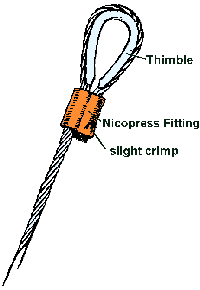|
Need custom swaging? Click here for more information.
These swage sleeves come in stainless steel, aluminum, copper, and zinc covered copper. The later three are easily crimped with hand tools, but the stainless requires more pressure, usually a hydraulic device. Aluminum sleeves are not for use in the marine environment. All the hand tools are available in our Tool Section of the web site. We also carry a hydraulic swager, give us a call for more info. They are sometimes referred to as "oval swages" because the opening for the two wires, laying side by side, has an oval shape. They provide quick and secure eye creation, plus you can get specially designed ones for use as stops on wires (call us for info on these).
For eye splices, one stainless oval sleeve will hold full rated cable strength on 7 x 7 or 7 x 19 cable. On 1 x 19 we recommend using two stainless oval sleeves at each end to hold full rated strength. The copper sleeves hold almost at full cable strength; to be conservative estimate about 80%. Again, use 2 sleeves on 1 x 19 wire. Aluminum swage sleeves will only hold about one half the cable strength. Also, always use a stainless steel thimble inside of the wire eye.
We can do swaging for you, just give us the measurements! Click here for custom swaging.
The following is and excerpt from Brion Toss's book "The Complete Rigger's Apprentice" on these oval swages. (You might like to pick this book up if you don't have it... a valuable resoure!)
"NOTES ON CRIMPED WIRE FITTINGS
![]()
In consideration of matters aesthetic, we come to the Ugly Crimp-On Wire Fitting Dilemma. These fittings, generally known under the proprietary term Nicopress, are commonly used to form eyes on wire rigging, particularly for small (1/4 inch and less) wire. The fittings properly applied, are inexpensive, strong, and quick to make. But they are also ugly, and have hard corners and a little bit of bristly wire end sticking out. To correct these drawbacks, try wrapping some heat-shrink tape over the finished fitting, or thread on some heavy-duty heat-shrink tubing before making the eye, then slide the tubing down over the finished fitting. Apply a little hot air, and you have a suddenly smoother, nearly attractive terminal. Industrial-cute. It’s also good practice to slather the fitting, and any wire that will be shrink-wrapped, with anhydrous lanolin.
-
Nicopress fittings are wonderfully convenient, but can involve some wrestling during setup. The end is threaded through one side of the fitting, bent to form an eye, then threaded back through on the other side of the fitting. The wrestling comes when you’re trying to hold the end so that it projects just slightly beyond the end of the fitting, while you pull on the standing part to snug the eye down around the thimble. Further wrestling ensues when you try to hold the entire spring-load assembly still while you crimp the fitting. To eliminate both problems, lightly crimp the corner of the fitting where the end projects, while the eye is still loose. Use a vise, pliers, Visegrips, etc. With the end locked in place, it’s easy to adjust and hold eye size while pressing.
-
When setting up, allow for sleeve lengthening by positioning the sleeve slightly below the thimble, and with the end projecting slightly beyond the sleeve. If this is not done, the sleeve will be distorted as it mashes into the thimble, and the end will slip inside the sleeve, losing bearing surface and thus strength and security.
-
When crimping sleeves that require three crimps, crimp the middle first, then the thimble end, then the standing part end. This lets the sleeve expand away from the middle, preventing internal stresses. For sleeves requiring four crimps, start at the standing-part side of center and work toward the thimble. Finish with the standing-part end."
|


